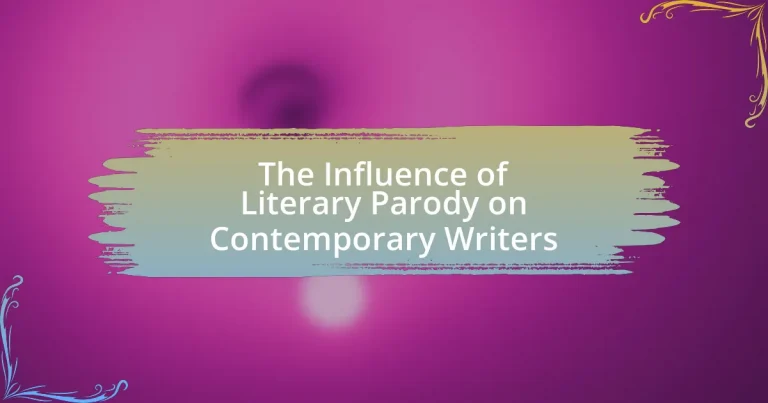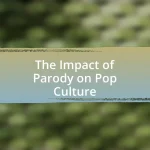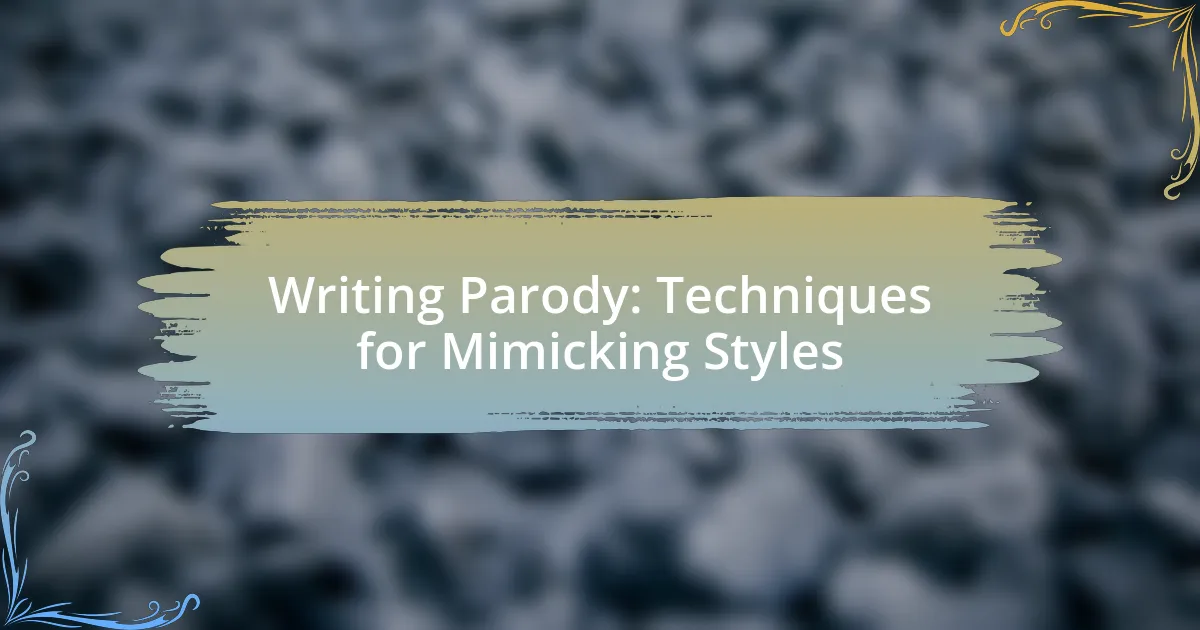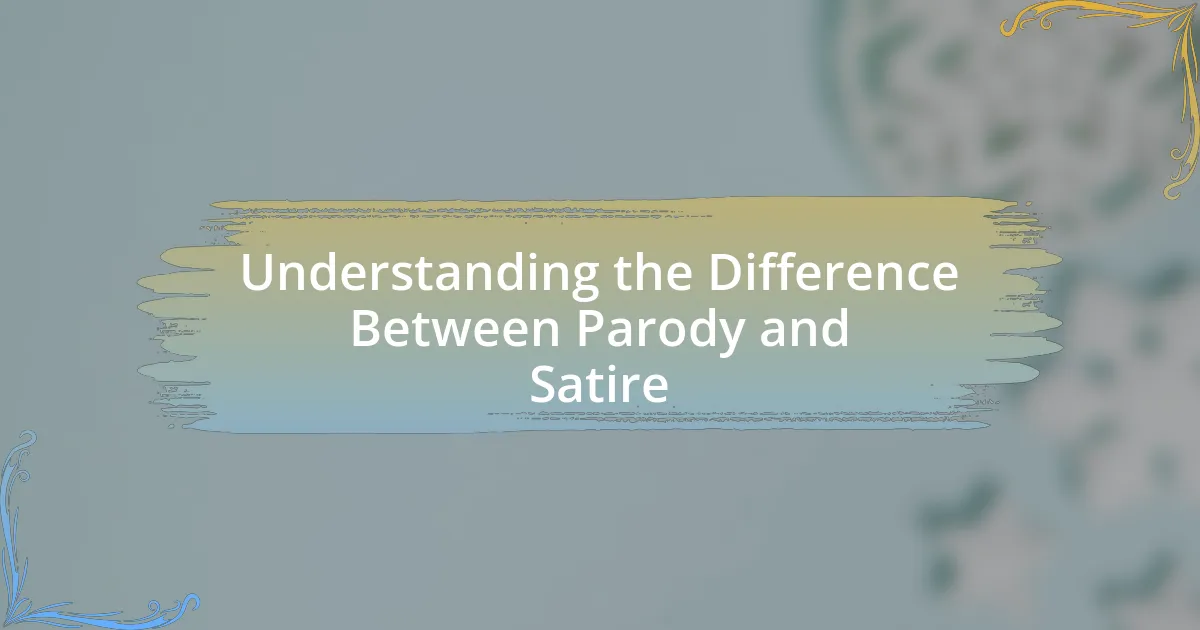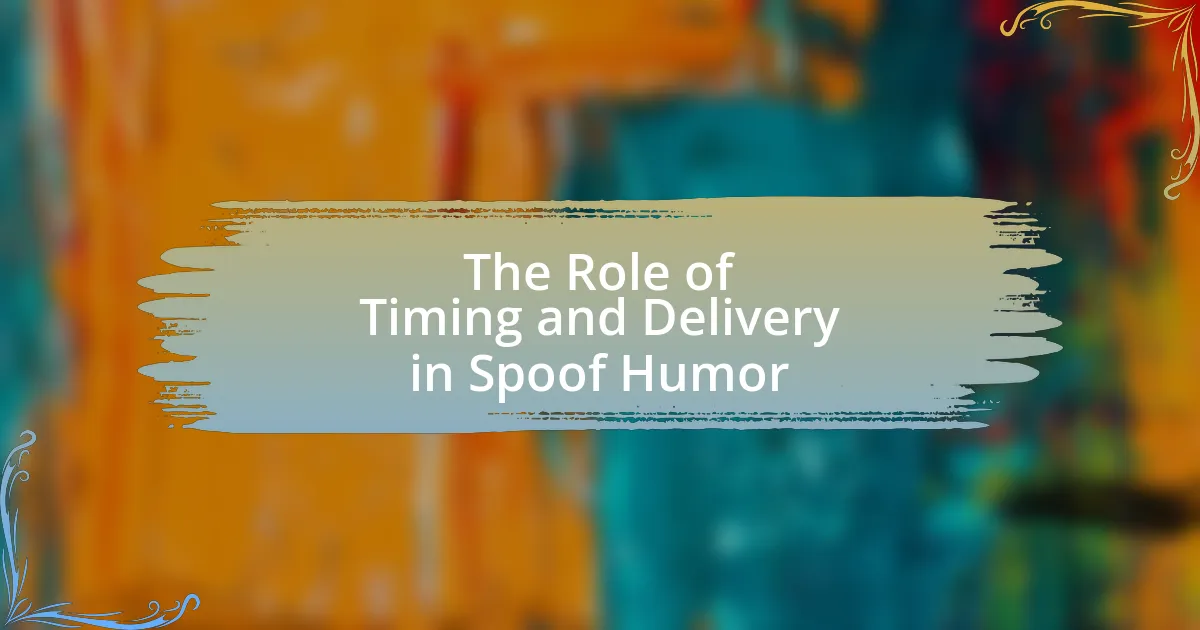Literary parody plays a significant role in shaping contemporary writing by providing a framework for critique and innovation within established genres. It allows authors to deconstruct traditional narratives, challenge societal norms, and engage readers through humor and irony. Key characteristics of literary parody include exaggeration, irony, and imitation, which serve to highlight the flaws of original works while provoking critical reflection. The article explores how contemporary writers utilize various forms of parody, the techniques employed, and the themes commonly addressed, emphasizing its importance as a tool for cultural commentary and social critique. Additionally, it discusses the distinctions between parody and satire, illustrating how parody influences reader perception and impacts the themes and messages in modern literature.
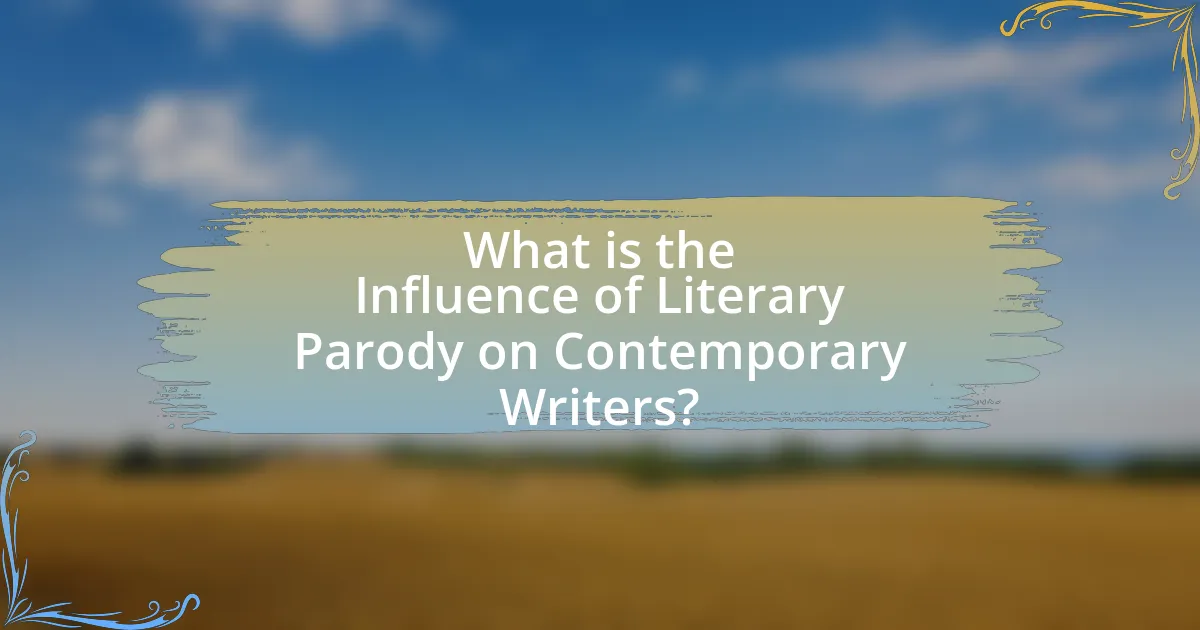
What is the Influence of Literary Parody on Contemporary Writers?
Literary parody significantly influences contemporary writers by providing a framework for critique and innovation within established genres. This influence manifests as writers utilize parody to deconstruct traditional narratives, challenge societal norms, and engage readers through humor and irony. For instance, authors like David Foster Wallace and Margaret Atwood employ parody to comment on cultural phenomena, thereby enriching their narratives and inviting deeper reflection. The effectiveness of parody in contemporary literature is evidenced by its prevalence in works that blend satire with serious themes, illustrating how parody can serve both as a tool for entertainment and a means of social commentary.
How does literary parody shape contemporary writing styles?
Literary parody shapes contemporary writing styles by providing a framework for authors to critique and reinterpret existing genres and conventions. This technique allows writers to blend humor with social commentary, often leading to innovative narrative structures and character development. For instance, works like “Pride and Prejudice and Zombies” by Seth Grahame-Smith exemplify how parody can merge traditional storytelling with modern themes, thereby influencing the stylistic choices of contemporary authors. Additionally, the rise of metafiction, where the text self-consciously addresses its own fictional status, can be traced back to parodic techniques, as seen in the works of authors like David Foster Wallace. This interplay between parody and contemporary writing fosters a dynamic literary landscape that encourages experimentation and critical engagement with established norms.
What are the key characteristics of literary parody?
Literary parody is characterized by its humorous imitation of a specific work or genre, often exaggerating its style and conventions for comedic effect. This form of satire typically employs techniques such as exaggeration, irony, and juxtaposition to highlight the original work’s flaws or absurdities. For instance, notable examples include “Don Quixote” by Miguel de Cervantes, which parodies chivalric romances, and “The Onion” which parodies journalistic styles. These characteristics serve to both entertain and provoke critical reflection on the source material, demonstrating the enduring influence of parody in literature.
How does parody differ from satire in contemporary literature?
Parody differs from satire in contemporary literature primarily in its intent and execution. Parody aims to imitate and exaggerate the style of a particular work or genre for comedic effect, often celebrating the original while poking fun at its conventions. In contrast, satire seeks to critique and expose societal flaws, using humor as a tool to provoke thought and inspire change. For example, a contemporary parody might mimic the writing style of a popular fantasy series to entertain readers, while a satire would use that same genre to comment on real-world issues like consumerism or political corruption. This distinction highlights how parody focuses on form and style, whereas satire emphasizes content and social commentary.
Why is literary parody significant in modern literature?
Literary parody is significant in modern literature because it serves as a critical tool for commentary and reflection on societal norms and literary conventions. By imitating and exaggerating the style of existing works, parody allows authors to challenge established narratives and provoke thought among readers. For instance, works like “Pride and Prejudice and Zombies” by Seth Grahame-Smith not only entertain but also critique the original text and its cultural context, highlighting issues such as gender roles and societal expectations. This dual function of parody—entertainment and critique—enhances its relevance in contemporary literature, making it a vital form of expression for modern writers.
What role does parody play in cultural commentary?
Parody serves as a critical tool in cultural commentary by allowing creators to satirize and critique societal norms, behaviors, and institutions. Through exaggeration and imitation, parody highlights the absurdities and contradictions within cultural phenomena, prompting audiences to reflect on their values and beliefs. For instance, works like “The Onion” and “Saturday Night Live” utilize parody to address political and social issues, effectively engaging viewers in discourse about current events. This method not only entertains but also encourages critical thinking, making parody a significant vehicle for cultural critique and awareness.
How does parody influence reader perception of original works?
Parody significantly influences reader perception of original works by providing a critical lens through which the original can be re-evaluated. This reinterpretation often highlights the original’s themes, styles, or cultural contexts, prompting readers to reconsider their understanding and appreciation of the source material. For example, when a well-known literary work is parodied, it can expose its flaws or absurdities, leading readers to question the validity of the original’s narrative or message. Studies, such as those by Linda Hutcheon in “A Theory of Parody,” demonstrate that parody not only entertains but also engages readers in a dialogue about the original text, enhancing their critical thinking and awareness of literary conventions.
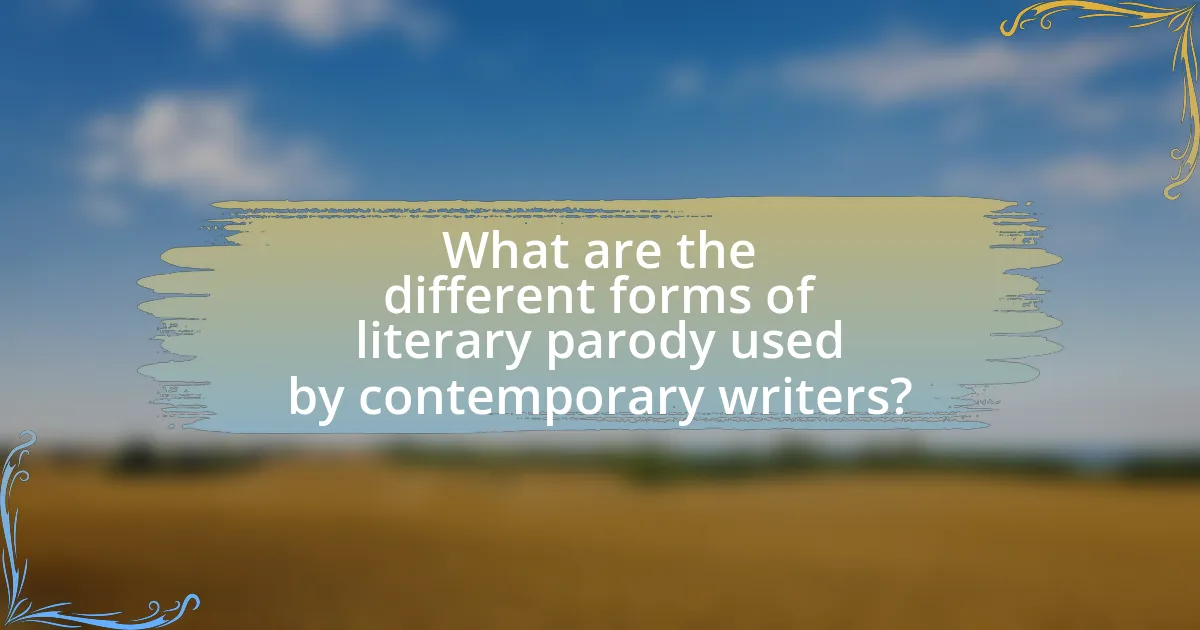
What are the different forms of literary parody used by contemporary writers?
Contemporary writers utilize various forms of literary parody, including satirical parody, genre parody, and self-parody. Satirical parody critiques societal norms and cultural phenomena, often employing humor to expose flaws, as seen in works like “The Sellout” by Paul Beatty. Genre parody mimics and exaggerates the conventions of specific genres, such as in “Pride and Prejudice and Zombies” by Seth Grahame-Smith, which blends horror with classic literature. Self-parody occurs when authors humorously reference their own works or styles, exemplified by Douglas Adams in “Dirk Gently’s Holistic Detective Agency.” These forms demonstrate how contemporary writers engage with and reinterpret existing literary traditions.
How do contemporary writers utilize parody in their works?
Contemporary writers utilize parody as a tool to critique societal norms, cultural phenomena, and literary conventions. By mimicking the style and structure of existing works, these authors highlight absurdities and contradictions within the original texts or the subjects they address. For instance, works like “The Sellout” by Paul Beatty employ parody to explore racial issues in America, using humor and satire to provoke thought and discussion. This method not only entertains but also encourages readers to reflect on the underlying messages, demonstrating the effectiveness of parody in engaging with complex themes.
What are some notable examples of literary parody in recent literature?
Notable examples of literary parody in recent literature include “Pride and Prejudice and Zombies” by Seth Grahame-Smith, which combines Jane Austen’s classic with elements of horror, and “The Wind Done Gone” by Alice Randall, a retelling of “Gone with the Wind” from a different perspective. These works exemplify how contemporary authors utilize parody to critique original texts and explore new themes, demonstrating the ongoing influence of literary parody in shaping modern narratives.
How do different genres incorporate parody?
Different genres incorporate parody by using humor and exaggeration to critique or mimic their own conventions and tropes. For instance, in literature, genres like satire and comedy often employ parody to highlight societal issues or absurdities within their narratives, as seen in works like “Don Quixote” by Miguel de Cervantes, which parodies chivalric romances. In film, genres such as horror and action frequently utilize parody to subvert audience expectations, exemplified by movies like “Scary Movie,” which mocks horror film clichés. Additionally, music genres like pop and rock may incorporate parody through humorous reinterpretations of popular songs, as demonstrated by “Weird Al” Yankovic’s parodies that comment on contemporary culture. These examples illustrate how parody serves as a tool for critique and entertainment across various genres.
What techniques do writers employ in literary parody?
Writers employ several techniques in literary parody, including exaggeration, imitation, and juxtaposition. Exaggeration amplifies the characteristics of the original work, making them more absurd or ridiculous, which highlights the flaws or conventions of the genre being parodied. Imitation involves closely mimicking the style, tone, or structure of the original text, allowing readers to recognize the source while also critiquing it. Juxtaposition places contrasting elements side by side, often revealing the absurdity of the original work’s themes or ideas. These techniques effectively engage readers and provoke thought about the original material, as seen in works like “Don Quixote” by Miguel de Cervantes, which parodies chivalric romances, or “The Onion” in its satirical take on news articles.
How does intertextuality enhance the effectiveness of parody?
Intertextuality enhances the effectiveness of parody by creating a layered understanding that relies on the audience’s familiarity with the original texts being referenced. This familiarity allows the parody to draw humor and critique from the contrasts between the original and the parodied work, making the satire more impactful. For instance, when a parody references a well-known literary work, it can highlight absurdities or flaws in the original by exaggerating its themes or styles, thus engaging the audience in a deeper analysis of both texts. The effectiveness of this technique is evident in works like “Don Quixote,” which parodies chivalric romances, leading readers to reconsider the conventions of those narratives.
What stylistic devices are commonly used in literary parody?
Literary parody commonly employs stylistic devices such as exaggeration, irony, and imitation. Exaggeration amplifies characteristics of the original work to create humor or critique, while irony highlights the contrast between the original intent and the parodic interpretation. Imitation mimics the style, tone, or structure of the original text, often to reveal its absurdities. These devices are essential in parody as they allow writers to engage with and comment on the source material, making the parody both recognizable and impactful.
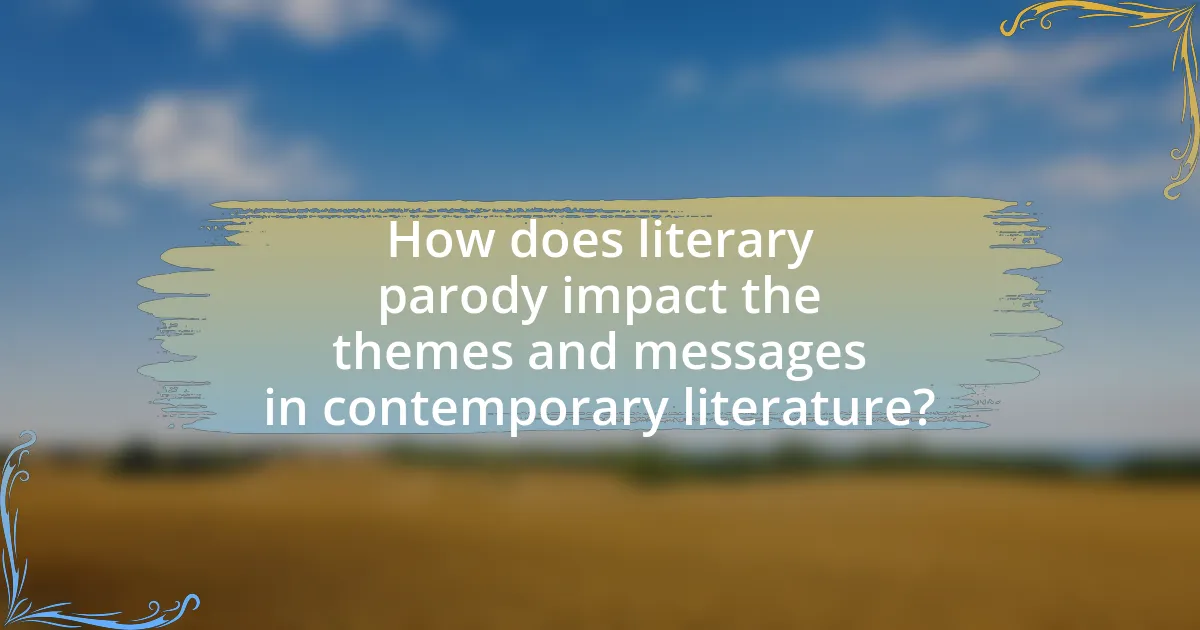
How does literary parody impact the themes and messages in contemporary literature?
Literary parody significantly impacts the themes and messages in contemporary literature by allowing authors to critique and reinterpret existing works, thereby reshaping cultural narratives. Through parody, writers can highlight societal issues, question established norms, and provide commentary on the original texts, which often leads to a deeper understanding of the themes being addressed. For instance, works like “Pride and Prejudice and Zombies” by Seth Grahame-Smith not only entertain but also provoke thought about gender roles and societal expectations by juxtaposing horror elements with classic literature. This blending of genres and themes through parody encourages readers to engage with the material on multiple levels, fostering a critical examination of both the parodied work and the contemporary issues it reflects.
What themes are commonly explored through literary parody?
Literary parody commonly explores themes such as social critique, identity, and the nature of art itself. Social critique is often evident as parodies highlight societal norms and conventions, exposing their absurdities, as seen in works like “Don Quixote” by Miguel de Cervantes, which satirizes chivalric romances. Identity is another prevalent theme, where parodies question and play with notions of self and persona, exemplified in “The Importance of Being Earnest” by Oscar Wilde, which mocks Victorian social identities. Additionally, the nature of art is scrutinized, as parodies often reflect on artistic conventions and styles, evident in works like “The Rape of the Lock” by Alexander Pope, which parodies epic poetry to comment on the triviality of high society. These themes collectively illustrate how literary parody serves as a powerful tool for commentary and reflection in literature.
How does parody challenge traditional narratives and tropes?
Parody challenges traditional narratives and tropes by subverting established conventions and highlighting their absurdities. Through exaggeration and imitation, parody exposes the limitations and clichés inherent in these narratives, prompting audiences to question their validity. For example, works like “Don Quixote” by Miguel de Cervantes not only mock chivalric romances but also encourage readers to reconsider the romanticized ideals of heroism. This critical lens fosters a deeper understanding of the original narratives, revealing their cultural and social constructs. By doing so, parody not only entertains but also serves as a tool for reflection and critique, reshaping how contemporary writers approach storytelling.
What messages do contemporary writers convey through parody?
Contemporary writers convey messages of social critique, cultural commentary, and the absurdity of human behavior through parody. By imitating and exaggerating established genres, styles, or societal norms, these writers highlight inconsistencies and provoke thought regarding contemporary issues. For instance, works like “The Sellout” by Paul Beatty use parody to address race relations in America, illustrating the complexities and contradictions within societal perceptions. This method not only entertains but also encourages readers to reflect on the underlying truths of the subjects being parodied, making it a powerful tool for commentary and critique.
How can writers effectively use parody in their own work?
Writers can effectively use parody in their work by exaggerating and mimicking the style, tone, or themes of a particular genre or author to create humor or critique. This technique allows writers to highlight the absurdities or clichés within the original work, making it relatable and engaging for the audience. For instance, the success of works like “The Hunger Pains” by The Harvard Lampoon demonstrates how parody can resonate with readers by transforming familiar narratives into comedic interpretations, thus providing both entertainment and commentary on societal norms.
What best practices should writers follow when creating parody?
Writers creating parody should prioritize clarity, humor, and respect for the original work. Clarity ensures that the audience understands the references being made, while humor should be clever and relevant to the source material. Respect for the original work is crucial to avoid crossing into offensive territory, which can alienate audiences. For instance, successful parodies like “Weird Al” Yankovic’s song parodies maintain a balance between humor and homage, allowing audiences to appreciate both the original and the parody. This approach not only enhances the comedic effect but also fosters a positive reception among fans of the original work.
What common pitfalls should writers avoid in literary parody?
Writers should avoid several common pitfalls in literary parody, including lack of originality, excessive reliance on clichés, and failure to understand the source material. Lack of originality can lead to unengaging work that fails to resonate with readers, as parody thrives on fresh perspectives. Excessive reliance on clichés can make the parody predictable and uninspired, diminishing its comedic or critical impact. Additionally, failing to understand the source material can result in misinterpretations that alienate the audience, as effective parody requires a nuanced grasp of the original work’s themes, style, and context. These pitfalls can undermine the effectiveness of the parody and limit its ability to engage and entertain.
